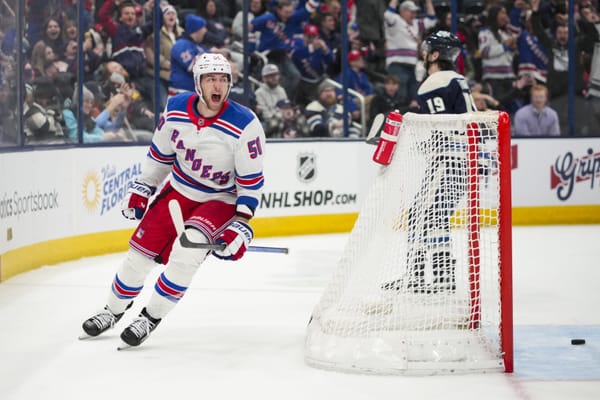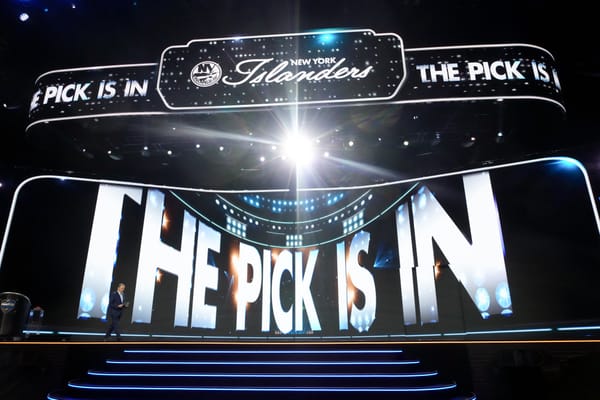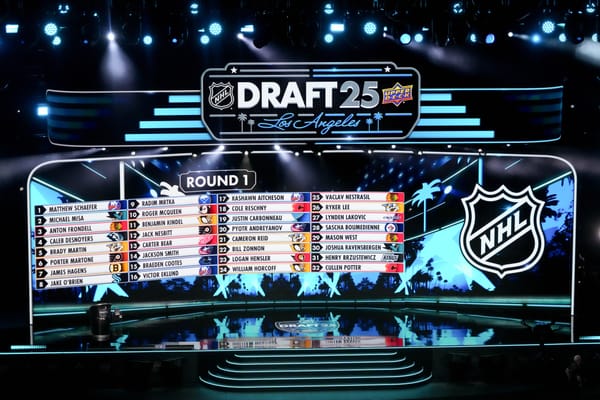The Day The New York Rangers' Music Died
The Rangers are at a crossroads. They might not have much control over what path they take, either.
Do you remember when you started believing in magic?
Was it watching the final seconds tick off in Game 7 of the Second Round against the Pittsburgh Penguins in 2014? Was it the knowledge that your team had just overcome a 3-1 deficit for the first time in organizational history?
Was it a more bittersweet moment? Was it Martin St. Louis' opening goal in Game 6 of that series when the Rangers were supposed to be dead in the water? On Mother's Day no less. Did you convert when you saw him slam his stick on the ice and throw himself into the boards; his facial expression revealing, for just a moment, everything he had been through the past 48 hours? Was it his speech? You know the one. Where he talked about how much it meant to him to be a Ranger. What about Derick Brassard holding him on the bench knowing it probably didn't help him feel better but that it was the right thing to do?
Maybe that wasn't enough for you, and really who could blame you? After years of missing the playoffs and then a wealth of good but not good enough group of players, the Rangers' 2014 run to The Cup came out of nowhere. Needing more to believe that year wouldn't have been a ridiculous desire.
Maybe you needed the exorcism that was Game 1 and 2 in Montreal. Maybe the face-goal to end Game 3 in the Habs' favor slowed the belief. But if it did then you must have believed after St. Louis rifled the puck off the crossbar and in to end overtime and give the Rangers a 3-1 lead in the Easter Conference Final, right? You must have believed then.
Try to remember the Henrik Lundqvist sprawling blocker save. Try to remember Dominic Moore's fist pump after the game's only goal of Game Six, twirling with his arms outstretched waiting for his teammates to mob him.
Do you remember the trophy? Hearing Brad Richards, Dan Carcillo and St. Louis (the only three players to win The Stanley Cup on that team) conversed to see if they would touch it and ultimately decided they wouldn't. Remember the smiles? The picture. The celebration.
If you were there do you remember the hallway outside The Garden. Do you remember how warm it was? How loud it was. Hearing "We Want The Cup" and getting the chills because holy shit they're actually playing for The Cup. Walking through the city, giving high fives to random strangers, the entire metropolis vibrating with the excitement of the team's success.
If you could freeze it there you would. You'd look at all the happy faces, walk through the halls of Madison Square Garden, float through the locker room, watch the celebrations, feel the moment. You'd appreciate the moment. You'd stay until the forces that be kicked you out.
At the time you looked forward to the future, demanded it, actually. But today you know the story ends with a goal and Lundqvist facedown on the ice incapable of being consoled. You know you didn't sleep that night because you couldn't get that image out of your head. Or the image of him sitting in the locker room after the game, face in his hands, untouched post-game food sitting next to him. That sucked.
When St. Louis' mother passed away and he played in Game 5 anyway I had one request: Bring him home. I didn't care about the series, I wanted him to get the ovation he deserved at Madison Square Garden for Game 6. He put his life on hold for us, at least let us stand for him and roar so loud he can't even hear. Give me that. Give us that.
They did, and then won the series.
Flash forward to Game 5 of the Stanley Cup Final. I felt cheated. Down 2-0 in the series and 1-0 and the end of the first in Game 3 I felt like I missed out on what The Garden should feel like during the Stanley Cup. So before Game 5 I had one request: Bring it home for Game 6. Could you imagine The Garden for a Game 6? I get the chills thinking about it now. So like a widow who waits every night for her husband by the edge of the sea in the old stories about shipwrecked sailors I watched and waited for them to come home.
They never came home.
The funny thing about the hike to the top of the mountain is if you don't make it you fall to the bottom. As in, all the way to the bottom.
In hindsight the decisions the Rangers made leading up to, and directly after, the Stanley Cup run is what led to the end you witnessed on Saturday. And even though the Rangers had an opportunity to fix their mistakes, a lack of foresight and an unwillingness to swallow their pride ended up sinking the ship and bringing the Stanley Cup window dangerously close to a close.
The Rangers have an opportunity to fix their problems this year, but they'd have to do it quickly and efficiently. They'd have to toss out dead wood contracts that are attached to loyal players who gave a lot to this organization in the past. They'd have to either bring Vigneault up to speed on which players he needs to start grooming and adjustments he needs to make to his system or jettison him for a coach who will.
This year felt like a bad dream. The past two years I've written very heartfelt articles at the end about how much it hurts to see a team die. This year the emotion isn't pain or an empty hole. It's a smoldering pile of embers. It's anger. The Rangers brass should have known this was coming and they stuck their heads in the sand. Vigneault did the same thing with his lineup and lack of adjustments. Another year of Lundqvist's prime was wasted because Glen Sather was too proud to fix his mistakes, Vigneault was too proud to do what was best for the team and Jeff Gorton -- who does get a pass on a lot of this -- didn't intervene soon enough (or at all) to try and patch the holes on a sinking ship.
Two years isn't that long in the grand scheme of things, but the difference between the summer of 2014 and the summer of 2016 is drastic. From a summer full of hope an expectations to a summer full of dread and concern. The Rangers' lack of flexibility looms like a storm over a parade. Their horrible contracts ensure the Rangers -- without movement -- might be stuck in the rain for a while.
The mentality has to change, first and foremost. The brass truly believed that going all in was more important than building to the goal. Seemingly overnight, from 2014 to 2015 the Rangers went from a team that believed in growth and development to a team willing to part with their best prospects to get meager returns.
Ryan Callahan's departure was a welcomed one -- if for no other reason than to avoid his horrific contract -- but Sather shouldn't have needed to sweeten the pot as much as he did to get a player who would only come to New York at the trade deadline. This is different from the Jonathan Drouin situation; there was no way the Lightning could have kept St. Louis in Tampa Bay. He commanded too much respect and would have been too big a headache to keep around.
The Keith Yandle trade will be remembered as one of the worst trades in organization history if Anthony Duclair continues his projected trajectory and the Rangers don't keep Yandle. The organization just recently moved one of their best prospects (Aleksi Saarela) and two second round picks for a single playoff win in the form of Eric Staal. These are not steps forward; they are major steps backward, and unless the Rangers can find a way to re-invest in the future this summer, they will live with yet another year of late picks and no infusion of youth.
That's a problem. A problem the Rangers haven't seemed to care about, continuing to re-structure their future, hoping a Stanley Cup parade will allow that future payment to be looked at as a casualty of success. Only that's not how things played out.
I understand it's easy to sit back and say "I told you so" when a team doesn't win a Stanley Cup. One team wins every year, and since only 16 teams make the playoffs, there's a raw 6.25% chance to see your name engraved on The Cup. Not very high odds. But there should be a fundamental difference between going all in and going in to do your best. The Rangers dished out steep payments to go all in three years in a row, with no payout. This year's all in was the most puzzling, as Gorton and company ignored the team's biggest issues and brought in a player to fix something that wasn't the problem -- although the offense played a major role in the team's eventual demise.
"Where to go from here" is the million dollar question. Ever see the overused photo or video where someone is standing before two paths. On one side the sun is out and it's beautiful and on the other it's stormy and raining and certain death awaits? The Rangers stand at that crossroad, and the control they have over which path they take might be out of their hands.
If Dan Girardi's immense struggles out-pace his reputation, the Rangers have little to no shot of moving him or his salary from this team without a buyout -- which comes with its own penalties. Same goes for Marc Staal. If the Rangers can't (or worse, aren't willing) to move them, then next year's only going to be worse. Same goes for Tanner Glass.
But it's not just removing the dead weight. Vigneault needs to come to terms with the reality that veterans might not be the best thing for the team. He has to let the youth make mistakes and flourish without looking over their backs wondering when the ax is coming down. Vigneault's subjective wheel of justice has helped breed an environment devoid of accountability and has taken away the team's creativity. That's another problem that reared its head in the playoffs and down the line of the regular season, but we can get to that over the summer.
Fundamental things have to change. The Rangers' upper management needs to get on board with advanced stats. They need to, at the very least, be able to distinguish good from lucky and progress in spite of process. Had they realized the Rangers early explosion was nothing more than unsustainable hockey and a God-mode Lundqvist, the Rangers might have been able to fix the problems before they festered into unmanageable wounds. Instead the Rangers were slowly bleeding out until they died on national television in Game Four.
This is written like a eulogy for a reason. The team of old is dead and buried. The older core of this team is part of the reason this team can't get off the ground now. It's upsetting and disorienting and it should be. Loyalty is very important, especially for an Original Six franchise with all the history the Rangers have, but it cannot stand in the way of progress.
The younger core of this team is the future, and it's a bright one. Guys like Derek Stepan and Ryan McDonagh might seem like they've been around forever, but they're 25 and 26-years-old respectively. Chris Kreider is 24, J.T. Miller is 23, Oscar Lindberg is 24, Kevin Hayes is 23, Brady Skjei is 22, Jesper Fast is 24 and Pavel Buchnevich is just 21. The Rangers have youth in key places, and they're guys who have grown in this era of success who know what it takes to go deep in the playoffs. That's not exactly common, and it's something all Stanley Cup dynasties have in common. The difference is that the Chicago's of the world know when to sell high and get rid of their problem players, even if they have to hold their noses to do it. The Rangers tried to do this exact thing with Carl Hagelin, but flopped marvelously when they wasted the one NHL asset they got in the deal and then saw Hagelin go to a division rival in a mid-year trade.
It's clear the strategy hasn't worked. The team the Rangers built in 2014 (read that again: BUILT, not paid for) was solid from the ground up. This year's team -- longer story alert: Vigneault has blood on his hands here -- was flawed from the ground up.
The Rangers got away with it on the back of Lundqvist, but eventually the wheels fell off the bus. It was predictable to anyone who paid attention.
Which the Rangers did not.





